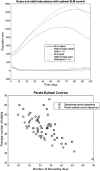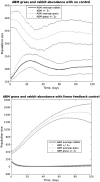Optimization and Control of Agent-Based Models in Biology: A Perspective
- PMID: 27826879
- PMCID: PMC5209420
- DOI: 10.1007/s11538-016-0225-6
Optimization and Control of Agent-Based Models in Biology: A Perspective
Abstract
Agent-based models (ABMs) have become an increasingly important mode of inquiry for the life sciences. They are particularly valuable for systems that are not understood well enough to build an equation-based model. These advantages, however, are counterbalanced by the difficulty of analyzing and using ABMs, due to the lack of the type of mathematical tools available for more traditional models, which leaves simulation as the primary approach. As models become large, simulation becomes challenging. This paper proposes a novel approach to two mathematical aspects of ABMs, optimization and control, and it presents a few first steps outlining how one might carry out this approach. Rather than viewing the ABM as a model, it is to be viewed as a surrogate for the actual system. For a given optimization or control problem (which may change over time), the surrogate system is modeled instead, using data from the ABM and a modeling framework for which ready-made mathematical tools exist, such as differential equations, or for which control strategies can explored more easily. Once the optimization problem is solved for the model of the surrogate, it is then lifted to the surrogate and tested. The final step is to lift the optimization solution from the surrogate system to the actual system. This program is illustrated with published work, using two relatively simple ABMs as a demonstration, Sugarscape and a consumer-resource ABM. Specific techniques discussed include dimension reduction and approximation of an ABM by difference equations as well systems of PDEs, related to certain specific control objectives. This demonstration illustrates the very challenging mathematical problems that need to be solved before this approach can be realistically applied to complex and large ABMs, current and future. The paper outlines a research program to address them.
Keywords: Agent-based modeling; Optimal control; Optimization; Systems theory.
Figures






References
-
- Armaou, A (2004). Continuous-time control of distributed processes via microscopic simulation. In: Proceedings of 2004 ACC, Boston, pp. 933–939
-
- Christley S, Miller Neilan R, Oremland M, Salinas R, Lenhart S (2015). Optimal control of SugarScape agent-based model via a PDE approximation model, preprint 2015
-
- Epstein J, Axtell R. Growing artificial societies. Boston: Brookings Institution Press; 1996.
-
- Eubank S. Network based models of infectious disease spread. Jpn J Infect Dis. 2005;58(6):S9–13. - PubMed
Publication types
MeSH terms
Grants and funding
LinkOut - more resources
Full Text Sources
Other Literature Sources
Research Materials

